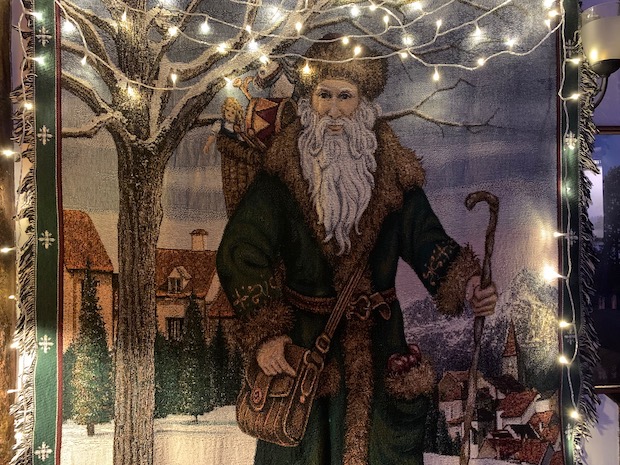Beware the Christmas Cannibal of France
How a whip-wielding butcher became St. Nick’s sidekick.
A Butcher, a man with a whip, and a jolly bishop walk into a bar. This is not, in fact, the opening line of a twisted joke—it’s preparation for the biggest day of the year in Nancy, an elegant city in France’s Lorraine region.
St. Nicholas Day is celebrated across many European countries on December 6 or the weekend following it. Each evening in Nancy from late November till early January, a lights display projects a story onto the opulent façade of the Hôtel de Ville. The expectant crowd watches as three children knock on the door of a local butcher, only to be chopped up into little pieces and left to cure in a salting pot. Falling snowflakes are replaced with chunks of veal.
You might be wondering what this gruesome scene has to do with St. Nicholas, who is the predecessor of Santa Claus. Often throughout Europe, St. Nicholas is said to be accompanied by an evil nemesis designed to frighten children into good behaviour. Germany has Hans Trapp, Holland has Zwarte Piet, and Austria is best known for the Krampus, a horned beast that charges the crowd with threatening roars.

In the Lorraine region of France, St. Nicholas’s companion is called Père Fouettard, meaning Father Whipper or Father Flog. He has a bit of a kinky vagabond look, wearing ragged clothes, donning a straggly black beard, and carrying a whip and chain. He’s also a butcher, and he attempts to eat children.
How did St. Nicholas get paired with a whip-wielding cannibal? The answer starts over 1,500 years ago with the origin of Santa Claus and evolved over the centuries thanks to a miraculous medieval battle in France, a heavy sprinkle of rumours, and some extraordinary embellishments.
It’s widely believed that St. Nicholas was from present-day Türkiye. He was likely the bishop of Myra, born towards the end of the 4th century in Patara. It’s said he performed miracles as an infant and during his life. The bishop died on December 6, 343. It was believed his body produced an oil that held healing properties, which scientists think was actually water from the damp tomb. In the 11th century, merchants from Italy launched a quest to retrieve his body. They were successful: The bishop’s remains were exhumed and brought to Bari.
Word spread, and people all over Europe wanted a piece. During the first crusade (1096–99), a lord of Lorraine raided St. Nicholas’s tomb in Italy, severed the tip of his finger, brought it back to his French homeland, and built a church to house the relic in Saint-Nicolas-de-Port. The saint therefore became highly revered throughout Lorraine.
A few centuries later, St. Nicholas is thought to have saved the people of this region during battle. In 1476, Charles the Bold laid siege to the city of Nancy. Charles had been overtaking much of France, so it should have been an easy win. Food within the city was running out, and many citizens resorted to eating rats. “It’s thought many of the inhabitants turned to cannibalism during the siege, out of desperation,” adds Nadia Hardy, a historical guide in Nancy. But René II, Duke of Lorraine, prayed for victory over St. Nicholas’s severed phalange, now over a millennium old. Miraculously, Nancy won the battle. St. Nicholas became the hero of the story and the region’s patron saint.
But what of his whipping, child-eating nemesis? The story of Père Fouettard comes from another battle in Lorraine. In 1552, Charles V, King of Spain and Emperor of the Holy Roman Empire, laid siege to the neighbouring city of Metz. Citizens created a grotesque effigy of Charles V, which they paraded through the streets before publicly burning it. Made by whip weidling tanners, the effigy became known as Père Fouettard (Father Whipper), an enemy of St. Nicholas.
At some point along the way, the figure gets mixed in with a sprinkle of cannibalism. Another legend tells of a butcher named Pierre Lenoir (or Peter Black), who chopped up three unfortunate children. He left them to marinate in a barrel for seven years before he received a knock at the door, and a surprise visitor: a hungry St. Nicholas, who the butcher recognised instantly. Loathe to feed human flesh to such a holy man, he claimed he had no food left. St. Nicholas placed three fingers on the salting barrel and resurrected the children, who, far from experiencing any profound trauma one might expect, felt as though they’d been awoken from a deep slumber.

“It’s likely that the stories of the butcher and Père Fouettard merged over time,” Hardy explains. Today in Nancy, the two characters are inextricably intertwined. Every December, not only is there, a projection of the tale, the townspeople also reenact the story.
“I’ve watched the St. Nicholas parades ever since I was a child,” says the man playing Père Fouettard this year. (The performer asked to remain anonymous “to preserve the magic,” as he says.) “I want my character to disgust people, not scare them.” The actor rubs dirt all over his face, attaches a long and dark beard, blackens out some of his teeth, and adorns a hooded brown cape. He makes a guttural growl like a dog and heads out to the festivities.
After the butcher, Père Fouettard, and St. Nicholas drink their pre-parade beverage (after all, it’s cold in Nancy in December), the event begins in town. During the reenactment, three local children visit the butcher and are depicted as being sliced, quartered, and salted. Salvation appears in the form of St. Nick astride a brightly lit carnival float, who resurrects the children. The butcher then morphs into Père Fouettard, doomed to follow St. Nicholas and dole out punishments to naughty children. He springs up in the crowd with his whip, giving out coal or sometimes turnips and potatoes.
St. Nicholas then climbs to the balcony of the Hôtel de Ville to greet the crowds. The mayor of Nancy presents him with a set of keys to the town, and the Christmas tree and Art Nouveau street lights crackle to life again. The butcher and Père Fouettard have both been overcome and must wait another year to scare the children of France into behaving.

Article thanks to Anna Richards for Atlas Obscura..
For everything you need to know about French property visit www.clefrance.co.uk